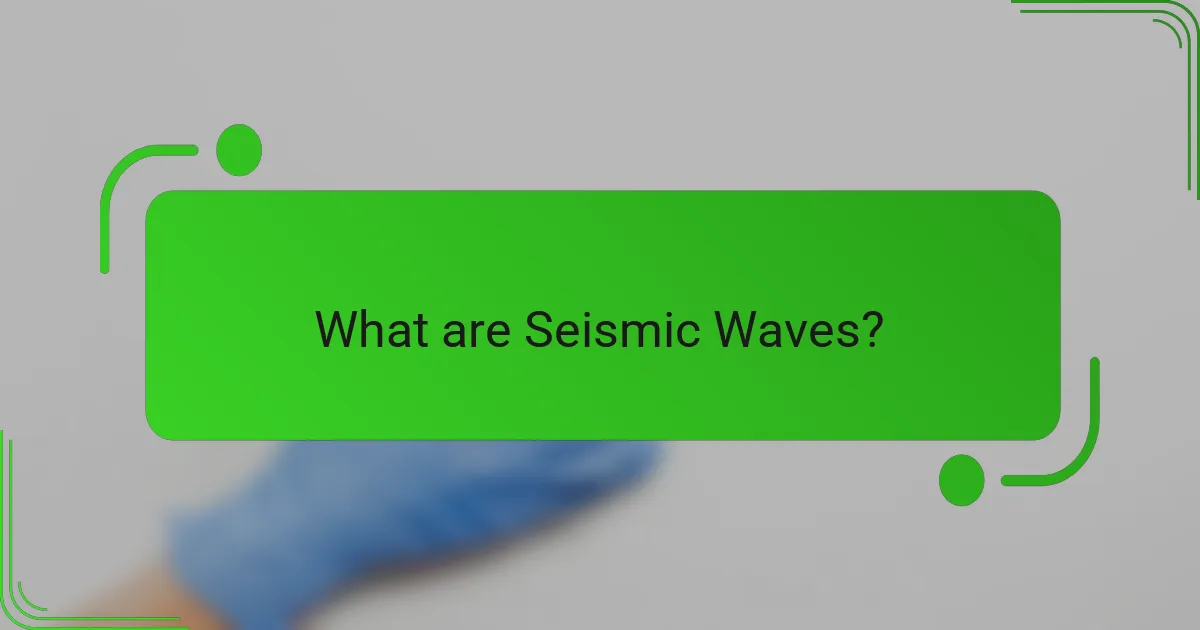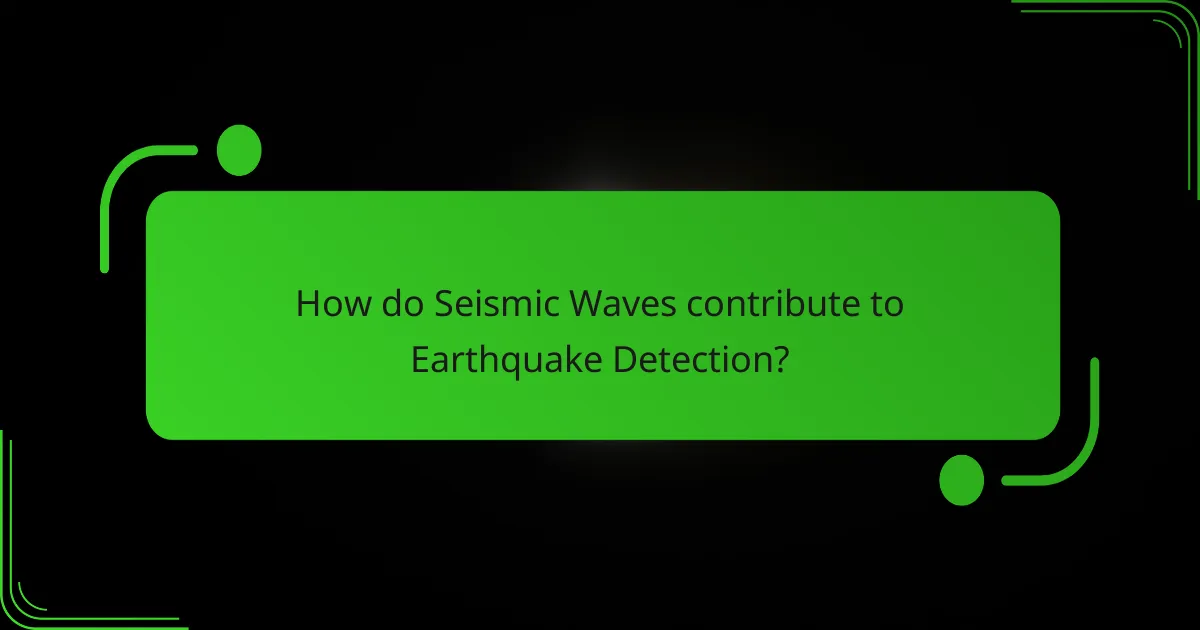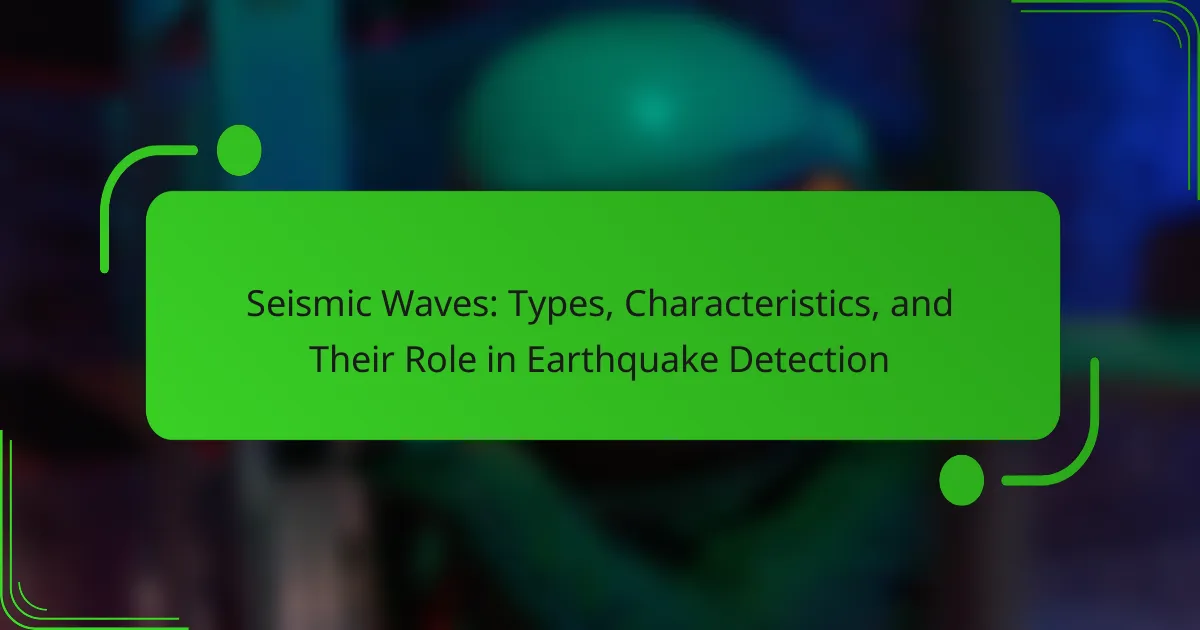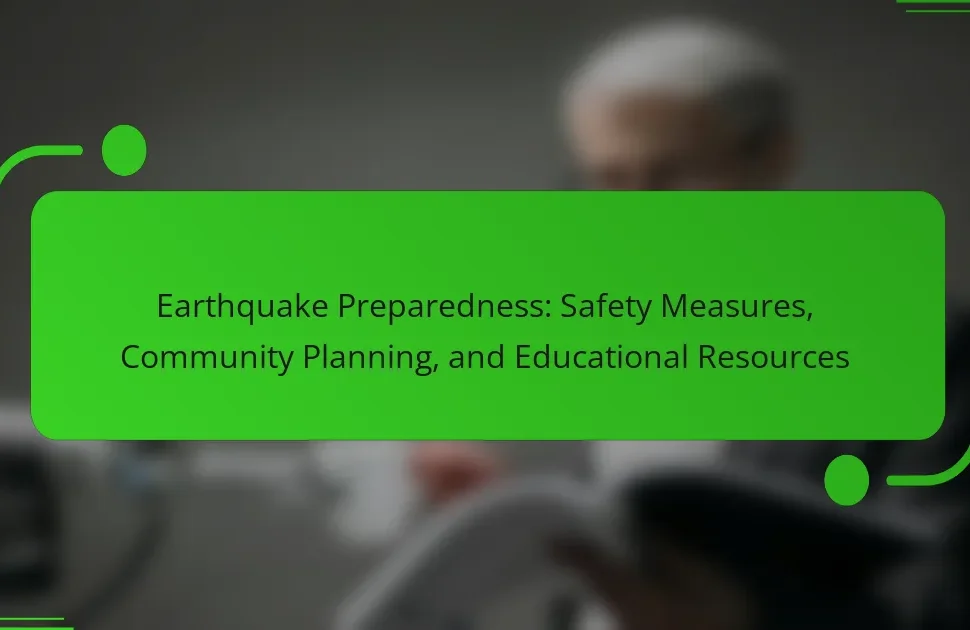Seismic waves are energy waves produced by the sudden release of energy in the Earth’s crust, primarily during earthquakes. They are categorized into two main types: body waves, which include primary (P) waves and secondary (S) waves, and surface waves. P-waves travel faster and can move through solids and liquids, while S-waves are slower and only travel through solids. Seismic waves are essential for detecting and analyzing earthquakes, providing crucial data on their location and magnitude through methods such as triangulation. Additionally, these waves have practical applications in fields like oil and gas exploration, engineering, and scientific research, enhancing safety and resource management.

What are Seismic Waves?
Seismic waves are energy waves generated by the sudden release of energy in the Earth’s crust. They occur during events like earthquakes. Seismic waves travel through the Earth and are crucial for understanding its internal structure. There are two primary types of seismic waves: body waves and surface waves. Body waves include P-waves and S-waves, which travel through the Earth’s interior. P-waves are compressional waves that move faster than S-waves. S-waves are shear waves that cannot travel through liquids. Surface waves travel along the Earth’s surface and typically cause the most damage during an earthquake. Their characteristics help seismologists determine the location and magnitude of seismic events.
How are Seismic Waves generated?
Seismic waves are generated primarily by the sudden release of energy in the Earth’s crust. This release often occurs during an earthquake. When tectonic plates shift, they create stress that accumulates over time. Once the stress exceeds the strength of rocks, a rupture occurs. This rupture propagates energy in the form of seismic waves. These waves travel through the Earth and can be detected by seismographs. The process is a fundamental aspect of earth science and geology.
What processes lead to the formation of Seismic Waves?
Seismic waves form as a result of energy release during geological events. These events include earthquakes, volcanic eruptions, and landslides. When stress builds up in the Earth’s crust, it eventually exceeds the strength of rocks. This sudden release of energy creates vibrations that propagate through the Earth. The vibrations travel in various forms, including primary (P) waves and secondary (S) waves. P waves are compressional and move faster than S waves, which are shear waves. The energy from the release can be measured by seismographs. This measurement helps scientists understand the magnitude and location of seismic events.
How do geological factors influence Seismic Wave generation?
Geological factors significantly influence seismic wave generation. The composition and structure of the Earth’s crust determine how seismic waves propagate. Different rock types have varying densities and elastic properties. These variations affect wave speed and amplitude. For instance, seismic waves travel faster through denser materials. Geological features like faults and fractures can also alter wave paths. In addition, the presence of water-saturated sediments can dampen seismic waves. This interaction between geological factors and seismic wave generation is critical for understanding earthquake behavior.
What are the different types of Seismic Waves?
Seismic waves are classified into two main types: body waves and surface waves. Body waves travel through the Earth’s interior. They are further divided into primary waves (P-waves) and secondary waves (S-waves). P-waves are compressional waves that move faster than S-waves. They can travel through solids, liquids, and gases. S-waves are shear waves that only move through solids. Surface waves travel along the Earth’s surface and are typically slower than body waves. They cause the most damage during earthquakes. The two main types of surface waves are Love waves and Rayleigh waves. Love waves move horizontally, while Rayleigh waves roll along the ground.
What distinguishes Primary Waves from Secondary Waves?
Primary Waves (P-waves) and Secondary Waves (S-waves) are two types of seismic waves. P-waves are compressional waves that travel faster than S-waves. They can move through solids, liquids, and gases. In contrast, S-waves are shear waves that only travel through solids. This fundamental difference in their movement is a key distinction. P-waves arrive first at seismic recording stations, followed by S-waves. The ability of P-waves to travel through different states of matter is due to their compressional nature. S-waves, being shear waves, cannot propagate through liquids, which is why they are not detected in the Earth’s outer core.
How do Surface Waves behave compared to Body Waves?
Surface waves travel along the Earth’s surface and exhibit different behavior than body waves, which travel through the Earth’s interior. Surface waves typically have larger amplitudes and longer wavelengths, leading to more destructive shaking during an earthquake. They arrive after body waves during seismic events, causing the most damage to structures. Body waves include primary (P) waves and secondary (S) waves. P waves are compressional and travel faster, while S waves are shear and slower. This difference in speed means body waves are detected first by seismographs, while surface waves follow, often causing more significant ground movement.
What characteristics define Seismic Waves?
Seismic waves are vibrations that travel through the Earth, generated by geological phenomena. They are characterized by their speed, type, and motion. There are two primary types: body waves and surface waves. Body waves include P-waves, which are compressional and travel fastest, and S-waves, which are shear and follow P-waves. Surface waves travel along the Earth’s surface and typically cause the most damage during earthquakes. Seismic waves vary in amplitude and frequency, affecting how they are detected. Their propagation depends on the Earth’s material properties, such as density and elasticity.
How is the speed of Seismic Waves determined?
The speed of seismic waves is determined by the properties of the materials they travel through. Seismic waves propagate through different geological layers, each with unique density and elasticity. The speed increases in denser and more elastic materials. For example, primary waves (P-waves) travel faster than secondary waves (S-waves) due to their ability to move through solids and liquids.
The formula used to calculate wave speed is derived from the relationship between density and elastic modulus. Specifically, the speed can be expressed as the square root of the elastic modulus divided by density. This relationship is confirmed by experimental data from seismic studies.
Seismologists utilize seismic wave data to analyze the Earth’s internal structure. They measure the arrival times of waves at various seismic stations. This information allows for the calculation of wave speeds and the identification of different geological layers.
What roles do amplitude and frequency play in Seismic Waves?
Amplitude and frequency are critical characteristics of seismic waves. Amplitude refers to the maximum displacement of particles in the medium during wave propagation. Higher amplitude indicates stronger seismic energy, leading to more intense shaking during an earthquake. Frequency, on the other hand, is the number of wave cycles that occur in a given time period. It influences how quickly the seismic waves oscillate. Different frequencies affect how seismic waves travel through various geological materials. For instance, lower frequency waves can travel longer distances, while higher frequency waves dissipate energy more quickly. This relationship helps in understanding the potential impact of an earthquake on structures and the surrounding environment.

How do Seismic Waves contribute to Earthquake Detection?
Seismic waves are crucial for earthquake detection as they transmit energy released during seismic events. They are categorized into two main types: primary (P) waves and secondary (S) waves. P waves travel faster and arrive first at seismic monitoring stations. S waves follow and are more destructive.
Seismographs detect these waves and record their amplitude and frequency. The difference in arrival times between P and S waves helps determine the earthquake’s epicenter. This method is known as triangulation.
Seismic waves also provide information about the earthquake’s magnitude. The Richter scale quantifies this based on wave amplitude. Accurate detection of seismic waves enhances early warning systems, reducing potential damage and saving lives.
What methods are used to detect Seismic Waves?
Seismic waves are detected using several methods, primarily through seismometers. Seismometers measure ground motion caused by seismic waves. They consist of a mass suspended on a spring. When seismic waves pass, the mass moves while the frame remains stationary. This movement is converted into an electrical signal, which is recorded.
Another method involves the use of accelerometers. Accelerometers measure the acceleration of ground motion. They can provide real-time data about the intensity of seismic events.
Additionally, arrays of sensors can be deployed to triangulate the source of seismic waves. This technique improves the accuracy of locating the epicenter of earthquakes.
These methods have been validated by their use in monitoring seismic activity worldwide. Networks of seismometers and accelerometers have been established globally. They provide crucial data for understanding and predicting seismic events.
How do seismographs measure Seismic Waves?
Seismographs measure seismic waves by detecting ground motion caused by earthquakes. They consist of a mass suspended on a spring. When seismic waves travel through the Earth, they cause the ground to shake. This motion causes the mass to remain still while the frame of the seismograph moves. The relative motion between the mass and the frame is recorded. This recording is typically displayed as a seismogram. Seismograms show the amplitude and frequency of the seismic waves. Different types of seismic waves produce distinct patterns on the seismogram. This allows scientists to analyze the characteristics of the seismic waves and determine their source.
What advancements have improved Seismic Wave detection technology?
Advancements in seismic wave detection technology include improved sensor sensitivity and data processing algorithms. Enhanced sensors can detect smaller seismic events with greater accuracy. Innovations such as fiber-optic sensors allow for real-time monitoring over vast distances. Advanced machine learning algorithms analyze seismic data more efficiently. These algorithms can identify patterns and predict seismic activities. Additionally, the integration of satellite data provides a broader context for seismic events. Research shows that these advancements lead to better early warning systems. For instance, the ShakeAlert system in California utilizes these technologies to provide timely alerts.
Why is understanding Seismic Waves important for earthquake preparedness?
Understanding seismic waves is crucial for earthquake preparedness. Seismic waves are the energy released during an earthquake. They travel through the Earth and can vary in speed and intensity. Knowing the types of seismic waves, such as P-waves and S-waves, helps in predicting their effects. P-waves are faster and arrive first, while S-waves follow and cause more damage. This knowledge aids in developing early warning systems. Early warnings can save lives by allowing people to take cover. Additionally, understanding seismic waves informs building codes and safety measures. For instance, structures can be designed to withstand specific wave impacts. This proactive approach reduces injury and property damage during earthquakes.
How can Seismic Wave data inform building codes and safety regulations?
Seismic wave data can inform building codes and safety regulations by providing essential information about ground motion during earthquakes. This data helps engineers understand how different structures respond to seismic activity. By analyzing seismic wave patterns, codes can be developed to ensure buildings can withstand anticipated forces.
For example, the Uniform Building Code incorporates seismic data to establish design criteria for regions with varying earthquake risks. Historical seismic events provide a basis for these codes, ensuring they reflect real-world conditions. Areas with high seismicity may require stricter regulations, such as reinforced structures.
Research, such as the “Seismic Design Criteria” by the Federal Emergency Management Agency, emphasizes the importance of seismic data in developing effective building codes. By utilizing seismic wave data, safety regulations can be tailored to enhance public safety and reduce damage during earthquakes.
What role do Seismic Waves play in early warning systems?
Seismic waves play a crucial role in early warning systems for earthquakes. They are the vibrations that travel through the Earth after an earthquake occurs. Early warning systems detect these waves using a network of seismic sensors. These sensors identify the faster-moving primary waves (P-waves) before the slower secondary waves (S-waves) arrive.
The systems analyze the data from the P-waves to determine the earthquake’s location and magnitude. This information is processed rapidly, allowing alerts to be sent out seconds before the more destructive S-waves reach populated areas. Research indicates that timely alerts can provide critical seconds to minutes for safety measures, such as stopping trains or shutting down utilities.
For instance, the ShakeAlert system in California has demonstrated the effectiveness of this approach. It uses real-time data to issue warnings within seconds of detecting seismic activity. This capability has the potential to save lives and reduce injuries during seismic events.

What are the practical applications of Seismic Waves?
Seismic waves have several practical applications in various fields. They are primarily used in earthquake detection and monitoring. Seismologists analyze seismic waves to determine the location and magnitude of earthquakes. This data is crucial for public safety and disaster preparedness.
Additionally, seismic waves are used in oil and gas exploration. Geologists employ seismic surveys to locate potential reservoirs underground. This method enhances the efficiency of resource extraction.
Seismic waves also play a role in engineering. They help assess the structural integrity of buildings and infrastructure. Engineers use seismic data to design structures that can withstand earthquakes.
Furthermore, seismic waves contribute to scientific research. They provide insights into the Earth’s internal structure and composition. This information is vital for understanding geological processes.
Overall, seismic waves serve essential functions in safety, resource management, engineering, and scientific discovery.
How are Seismic Waves used in resource exploration?
Seismic waves are used in resource exploration to locate and assess subsurface resources. They provide critical data about geological formations. By generating seismic waves and analyzing their reflections, geologists can map the Earth’s subsurface structure. This technique is essential for oil and gas exploration. It helps identify potential reservoirs and assess their viability. Additionally, seismic waves are used in mineral exploration. They assist in locating valuable minerals by revealing the geological context. The effectiveness of this method is supported by its widespread use in the industry. Seismic surveys have been proven to enhance resource discovery rates significantly.
What is the significance of Seismic Waves in oil and gas exploration?
Seismic waves are crucial in oil and gas exploration as they help locate and map hydrocarbon reserves. These waves travel through the Earth’s subsurface, providing data on geological formations. By analyzing the reflected seismic waves, geologists can identify the presence of oil and gas deposits. This method, known as seismic surveying, enhances the accuracy of resource estimation. Seismic data can reveal the structure and composition of rock layers. It also aids in assessing reservoir properties, such as porosity and permeability. The use of seismic waves has significantly improved exploration success rates. Studies show that seismic techniques can reduce drilling costs by up to 30%.
How do Seismic Waves aid in mineral resource assessment?
Seismic waves aid in mineral resource assessment by providing data on subsurface geological structures. These waves travel through the Earth and are affected by different materials they encounter. By analyzing the speed and behavior of seismic waves, geologists can infer the type and location of mineral deposits. This technique is known as seismic reflection or refraction. For example, high-velocity seismic waves often indicate dense materials like metals or minerals. Additionally, seismic surveys can reveal faults or fractures that may host mineral resources. The effectiveness of this method has been demonstrated in various studies, including those conducted by the US Geological Survey, which show its reliability in mineral exploration.
What best practices can enhance the effectiveness of Seismic Wave monitoring?
Implementing best practices enhances the effectiveness of seismic wave monitoring. Regular calibration of monitoring equipment ensures accuracy in data collection. Utilizing a network of widely distributed sensors increases spatial coverage and data reliability. Continuous data analysis helps in identifying patterns and anomalies in seismic activity. Incorporating advanced algorithms improves the detection of subtle seismic events. Training personnel in data interpretation enhances decision-making during seismic events. Collaborating with geological experts provides insights into local tectonic activity. Regular maintenance of equipment prevents data loss and ensures optimal performance.
How can communities improve their response to Seismic Wave data?
Communities can improve their response to Seismic Wave data by enhancing data interpretation and communication systems. Implementing real-time monitoring networks allows for immediate analysis of seismic activity. Training local emergency responders on seismic data interpretation is crucial. This ensures that they can act swiftly during an earthquake.
Public education campaigns can raise awareness about seismic data significance. According to the U.S. Geological Survey, timely information can save lives and reduce property damage. Collaboration with scientific institutions can provide communities with expert insights.
Establishing clear communication channels for disseminating seismic alerts is essential. This can include mobile alerts and community warning systems. Regular drills can prepare residents for effective responses when alerts are issued. Overall, integrating technology, education, and communication improves community resilience to seismic events.
What strategies can be implemented for effective Seismic Wave analysis?
Effective seismic wave analysis can be achieved through a combination of strategies. These strategies include utilizing advanced computational models for wave propagation. High-resolution seismic networks enhance data collection accuracy. Employing machine learning techniques allows for improved pattern recognition in seismic data. Integration of multi-scale data helps in understanding complex geological structures. Continuous monitoring systems provide real-time data for immediate analysis. Collaboration with interdisciplinary teams fosters innovative approaches to problem-solving. Regular calibration of equipment ensures data reliability. These strategies collectively enhance the effectiveness of seismic wave analysis in earthquake detection and research.
Seismic waves are energy waves generated by the sudden release of energy in the Earth’s crust, primarily during earthquakes. This article explores the types of seismic waves, including body waves (P-waves and S-waves) and surface waves, along with their characteristics and behaviors. It discusses how seismic waves are generated, their role in earthquake detection, and the methods used to measure them. Additionally, the article highlights the significance of seismic wave data in resource exploration, building safety regulations, and enhancing community preparedness for seismic events.




